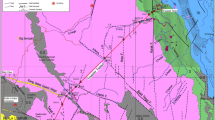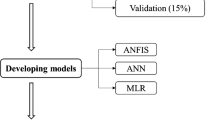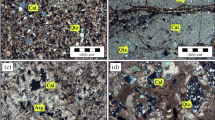Abstract
Thermal cracking significantly affects the dynamic and mechanical stability of rock mass. This study first focuses on the evaluation of dynamic-mechanical behavior of thermally deteriorated rocks in terms of their dynamic elastic Young’s modulus (Ed), quality factor (Q-factor), resonance frequency (Fr), unconfined compressive strength (UCS) and tensile strength (BTS). Secondly, it focuses on the comparison of the performance of different statistical data modeling techniques. The overall reduction in the values of Ed, Q-factor, Fr, UCS, and BTS for all thermally treated rock samples was recorded as 23–49%, 6–28%, 7–21%, 10–38%, and 14–56%, respectively. The previous studies do not show any significant correlation between the strength parameters of thermally deteriorated rocks. In this study, a total of 7 predictive models were developed to estimate Ed for thermally deteriorated rocks using linear-nonlinear regression analysis, regularization, and adaptive-neuro fuzzy inference system (ANFIS). Results of hypothesis testing showed that the linear-nonlinear regression equations were statistically significant. Similarly, outcomes of neuro-fuzzy logic analysis, based on the degree of thermal cracking of rocks satisfied the statistical significance of the ANFIS model. Among all prediction models, the ANFIS model has the lowest value of root mean square error (RMSE) and the highest value of the Nash–Sutcliffe coefficient (E). Based on the results of model quality indices, these statistical modeling techniques are arranged in the following order; ANFIS > Nonlinear Regression > Regularization > Linear Regression. The outcomes of this study can provide references to solve complex problems in geostatistics.









Similar content being viewed by others
Abbreviations
- E d :
-
Dynamic elastic Young’s modulus
- Q-factor:
-
Quality factor in the longitudinal direction
- F r :
-
Resonance frequency n the longitudinal direction
- UCS:
-
Unconfined compressive strength
- BTS:
-
Brazillian tensile strength
- β n :
-
Assigned weights to predictors in the regression equation
- ε :
-
Error term in the regression equation
- VIF:
-
Variance inflation factor
- LF:
-
Loss function
- L, R, and EN:
-
Lasso regression, Ridge regression, and Elastic Net regression respectively
- λ and α :
-
Tuning parameters for the regularized regression equation
- ANOVA:
-
Analysis of variance
- F-sig and t-sig:
-
Significance value to check the acceptance or rejection of a hypothesis test
- ANFIS:
-
Adaptive neuro-fuzzy inference system
- RMSE:
-
Root mean square error
- E :
-
Nash–Sutcliffe coefficient
References
Aali KA, Parsinejad M, Rahmani B (2009) Estimation of saturation percentage of soil using multiple regression, ANN, and ANFIS techniques. Comput Inf Sci 2(3):127–136
Agha SR, Alnahhal MJ (2012) Neural network and multiple linear regression to predict school children dimensions for ergonomic school furniture design. Appl Ergon 43(6):979–984
Ahmed MF, Waqas U, Arshad M, Rogers JD (2018) Effect of heat treatment on dynamic properties of selected rock types taken from the Salt Range in Pakistan. Arab J Geosci 11(22):728
Akan RS, Nilay K, Soner U (2015) Multiple regression model for the prediction of unconfined compressive strength of jet grout columns. Proc Earth Planet Sci 15:299–303
ASTM C215 (2019) Standard test method for fundamental transverse, longitudinal, and torsional resonant frequencies of concrete specimens. ASTM International, West Conshohocken, https://www.astm.org/cgi-bin/resolver.cgi?C215
ASTM D3967 (2016) Standard test method for splitting tensile strength of intact rock core specimens. ASTM International, West Conshohocken, https://www.astm.org/cgi-bin/resolver.cgi?D3967
ASTM D7012 (2014) Standard test methods for compressive strength and elastic moduli of intact rock core specimens under varying states of stress and temperatures. ASTM International, West Conshohocken, https://www.astm.org/cgi-bin/resolver.cgi?D7012
Bates DM, Watts DG (1988) Nonlinear regression analysis and its applications. Wiley, New York
Bauer SJ, Johnson B (1979) Effects of slow uniform heating on the physical properties of the Westerly and Charcoal granites. In 20th US symposium on rock mechanics (USRMS), American Rock Mechanics Association
Blake OO, Faulkner DR (2016) The effect of fracture density and stress state on the static and dynamic bulk moduli of Westerly granite. J Geophys Res: Solid Earth 121(4):2382–2399. https://doi.org/10.1002/2015JB012310
Chaki S, Takarli M, Agbodjan WP (2008) Influence of thermal damage on physical properties of a granite rock: porosity, permeability and ultrasonic wave evolutions. Constr Build Mater 22(7):1456–1461
Davarpanah SM, Ván P, Vásárhelyi B (2020) Investigation of the relationship between dynamic and static deformation moduli of rocks. Geomech Geophys Geo-energ Geo-resour 6:29
Eissa EA, Kazi A (1988) Relation between static and dynamic Young’s moduli of rocks. Int J Rock Mech Mining Geomech Abstr 25(6)
Fjær E (2019) Relations between static and dynamic moduli of sedimentary rocks. Geophys Prospect 67(1):128–139
Freire-Lista DM, Fort R, Varas-Muriel MJ (2016) Thermal stress-induced microcracking in building granite. Eng Geol 206:83–93
Gurocak Z, Solanki P, Alemdag S, Zaman MM (2012) New considerations for empirical estimation of tensile strength of rocks. Eng Geol 145:1–8
Hernandez-Stefanoni JL, Ponce-Hernandez R (2006) Mapping the spatial variability of plant diversity in a tropical forest: comparison of spatial interpolation methods. Environ Monit Assess 117(1–3):307–334
Hoerl AE, Kennard RW (1970) Ridge regression: biased estimation for nonorthogonal problems. Technometrics 12(1):55–67
James G, Witten D, Hastie T, Tibshirani R (2013) An introduction to statistical learning. Springer, New York
Jang J (1993) ANFIS: adaptive network-based fuzzy inference system. IEEE T Syst Man Cyb 23(3):665–685
Johansson E, Rautakorpi J (2000) Rock mechanics stability at Olkiluoto, Hästholmen. Kivetty and Romuvaara, Posiva Oy
Karakus M, Kumral M, Kilic O (1997) Predicting elastic properties of intact rocks from index tests using multiple regression modeling. Int J Rock Mech Min Sci 42(2):323–330
Kaya A, Karaman K (2016) Utilizing the strength conversion factor in the estimation of uniaxial compressive strength from the point load index. Bull Eng Geol Env 75(1):341–357
Keshavarz M, Pellet FL, Loret B (2010) Damage and changes in mechanical properties of a gabbro thermally loaded up to 1000 C. Pure Appl Geophys 167(12):1511–1523
Kolesnikov YI (2009) Dispersion effect of velocities on the evaluation of material elasticity. J Min Sci 45:347–354
Koncagül EC, Santi PM (1999) Predicting the unconfined compressive strength of the Breathitt shale using slake durability, Shore hardness and rock structural properties. Int J Rock Mech Min Sci 36(2):139–153
Kosko B (1991) Neural networks and fuzzy systems, a dynamical systems approach. Englewood Ciffs
Kutner MH, Nachtsheim CJ, Neter J (2004) Simultaneous inferences and other topics in regression analysis. Applied linear regression models. McGraw-Hill Irwin, New York
Lau JS, Gorski B, Jackson R (1995) The effects of temperature and water-saturation on mechanical properties of Lac du Bonnet pink granite. In 8th ISRM Congress. Int Soc Rock Mech Rock Eng.
Reitermanova Z (2010) Data splitting. Proc WDS 10:31–36
Seber GAF, Wild CJ (2003) Nonlinear regression. Wiley, New York
Sehgal V, Tiwari MK, Chatterjee C (2014) Wavelet bootstrap multiple linear regression based hybrid modeling for daily river discharge forecasting. Water Resour Manag 28(10):2793–2811
Sengun N (2014) Influence of thermal damage on the physical and mechanical properties of carbonate rocks. Arab J Geosci 7(12):5543–5551
Singh TN, Kanchan R, Verma AK, Saigal K (2005) A comparative study of ANN and neuro-fuzzy for the prediction of dynamic constant of rock mass. J Earth Syst Sci 114(1):75–86
Siratovich PA, Villeneuve MC, Cole JW, Kennedy BM, Bégué F (2015) Saturated heating and quenching of three crustal rocks and implications for thermal stimulation of permeability in geothermal reservoirs. Int J Rock Mech Min Sci 80:265–280
Snee RD (1977) Validation of regression models: methods and examples. Technometrics 19(4):415–428
Sonmez H, Gokceoglu C, Ulusay R (2003) An application of fuzzy sets to the geological strength index (GSI) system used in rock engineering. Eng Appl Artif Intell 16(3):251–269
Tahmasebi P, Hezarkhani A (2011) Application of a modular feedforward neural network for grade estimation. Nat Resour Res 20(1):25–32
Takagi T, Sugeno M (1995) Nechetkaiya identificathiya system i primenenie dlya modeley i upravleniya. IEEE Trans Syst, Man Cybern 15(1):116–132
Tibshirani R (1996) Regression shrinkage and selection via the lasso. J Roy Stat Soc: Ser B (Methodol) 58(1):267–288
Vallejo LE, Welsh Jr RA, Robinson MK (1989) Correlation between unconfined compressive and point load strengths for Appalachian rocks. In: The 30th US Symposium on Rock Mechanics (USRMS), American Rock Mechanics Association
Vanheerden WL (1987) General relations between static and dynamic moduli of rocks. Int J Rock Mech Min Sci 24:381–385
Vidaurre D, Bielza C, Larrañaga P (2013) Classification of neural signals from sparse autoregressive features. Neurocomputing 111:21–26
Zhang ZX, Yu J, Kou SQ, Lindqvist PA (2001) Effects of high temperatures on dynamic rock fracture. Int J Rock Mech Min Sci 38(2):211–225
Zou H, Hastie T (2005) Regularization and variable selection via the elastic net. J Roy Stat Soc B 67:301–320
Author information
Authors and Affiliations
Corresponding author
Ethics declarations
Conflict of interest
On behalf of all authors, the corresponding author states that there is no conflict of interest.
Additional information
Publisher's Note
Springer Nature remains neutral with regard to jurisdictional claims in published maps and institutional affiliations.
Rights and permissions
About this article
Cite this article
Waqas, U., Ahmed, M.F. Prediction Modeling for the Estimation of Dynamic Elastic Young’s Modulus of Thermally Treated Sedimentary Rocks Using Linear–Nonlinear Regression Analysis, Regularization, and ANFIS. Rock Mech Rock Eng 53, 5411–5428 (2020). https://doi.org/10.1007/s00603-020-02219-8
Received:
Accepted:
Published:
Issue Date:
DOI: https://doi.org/10.1007/s00603-020-02219-8




